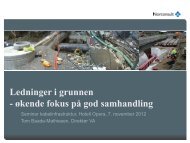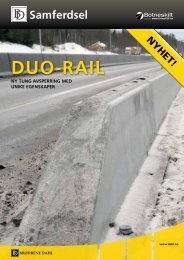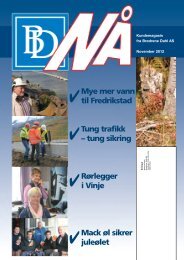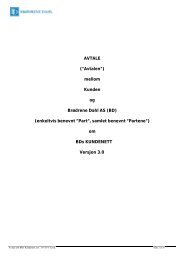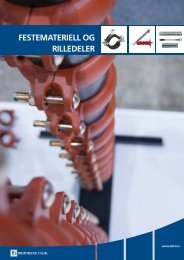Standard for the identification and labelling of products in the ... - GS1
Standard for the identification and labelling of products in the ... - GS1
Standard for the identification and labelling of products in the ... - GS1
You also want an ePaper? Increase the reach of your titles
YUMPU automatically turns print PDFs into web optimized ePapers that Google loves.
Packag<strong>in</strong>g levels <strong>for</strong> PHS goodsPHS goods are categorized <strong>in</strong>to <strong>the</strong> follow<strong>in</strong>g packag<strong>in</strong>g levels(All packag<strong>in</strong>g levels can be sold at all levels <strong>in</strong> <strong>the</strong> PHS Industry:F-packT-packD-packOnly F-pack5
2. General rules on <strong>identification</strong> <strong>and</strong> barcod<strong>in</strong>gIdentification <strong>of</strong> <strong>products</strong> – F-pack, D-pack <strong>and</strong> T-packIn <strong>the</strong> PHS Industry, <strong>products</strong> are identified by means <strong>of</strong> an NRF number written <strong>in</strong> human-readable <strong>for</strong>m<strong>and</strong> a GTIN (Global Trade Item Number) <strong>in</strong> <strong>the</strong> <strong>for</strong>m <strong>of</strong> a barcode <strong>and</strong> <strong>in</strong> human-readable <strong>for</strong>m.The NRF number is <strong>the</strong> Norwegian PHS Industry’s own seven-digit number<strong>in</strong>g system <strong>for</strong> <strong>identification</strong> <strong>of</strong><strong>products</strong>. Suppliers can order <strong>products</strong> <strong>and</strong> register relevant <strong>in</strong><strong>for</strong>mation at www.vvsnrf.no.GTIN is a global number<strong>in</strong>g system that ensures unique <strong>identification</strong> <strong>of</strong> <strong>products</strong>. A GTINcan have up to 14 digits. All packag<strong>in</strong>g levels: F-packs, D-packs <strong>and</strong> T-packs must have a unique GTIN.GTIN can have <strong>the</strong> follow<strong>in</strong>g <strong>for</strong>mats:GTIN-8 Used <strong>for</strong> small <strong>products</strong> (F-packs)GTIN-12 Used <strong>in</strong> <strong>the</strong> USA <strong>and</strong> Canada (F-packs, D-packs <strong>and</strong> T-packs)GTIN-13 Used <strong>for</strong> F-packs, D-packs <strong>and</strong> T-packsGTIN-14 Used <strong>for</strong> D-packs <strong>and</strong> T-packs. Not <strong>for</strong> F-packsExamples <strong>of</strong> bar codesEAN-8 EAN-13 UPC-A ITF-14Actors who receive <strong>and</strong> sell <strong>products</strong> from PHS suppliers, both nationally <strong>and</strong> <strong>in</strong>ternationally, must be ableto h<strong>and</strong>le <strong>the</strong> NRF number <strong>and</strong> all types <strong>of</strong> GTIN.NRF number: The st<strong>and</strong>ard rule is that NRF numbers are used only <strong>for</strong> F-packs. If a supplier wants to establish<strong>the</strong>ir own number<strong>in</strong>g system <strong>for</strong> <strong>the</strong>ir own packages, this can also be done via <strong>the</strong> NRF database.For F-packs, GTIN-13, GTIN-12 or GTIN-8 is used. GTIN-13 is <strong>the</strong> most commonly used <strong>and</strong> is <strong>the</strong> preferredchoice <strong>in</strong> <strong>the</strong> PHS Industry. For D-packs <strong>and</strong> T-packs (outer packag<strong>in</strong>g), all types GTIN can be used i.e. GTIN-14, GTIN-13, GTIN-12 or GTIN-8 (uncommon). GTIN-13 <strong>and</strong> GTIN-14 are most common on outer packag<strong>in</strong>g.NB!For suppliers who need to number <strong>and</strong> label <strong>the</strong>ir <strong>products</strong>, we recommend <strong>the</strong> use <strong>of</strong> GTIN-13 <strong>in</strong> additionto <strong>the</strong> NRF number. This applies on all packag<strong>in</strong>g levels, i.e. F-pack, D-pack <strong>and</strong> T-pack.For more <strong>in</strong><strong>for</strong>mation about <strong>the</strong> composition <strong>and</strong> structure <strong>of</strong> GTINs <strong>and</strong> <strong>labell<strong>in</strong>g</strong>, please refer to• <strong>GS1</strong> Global User Manual (http://www.gs1.no/sfiles/6/75/80/5/file/gs1_globalusermanual.pdf )• <strong>GS1</strong> Europe Logistics Label (http://www.gs1.no/sfiles/1/85/80/5/file/gs1_europe_logistic_label.pdf )These documents can be obta<strong>in</strong>ed from <strong>GS1</strong> Norway or can be downloaded from <strong>GS1</strong> Norway’s websitewww.gs1.no.6
General rules on <strong>identification</strong> <strong>and</strong> barcod<strong>in</strong>gRules <strong>for</strong> chang<strong>in</strong>g <strong>the</strong> GTINIf changes are made to exist<strong>in</strong>g <strong>products</strong>, <strong>the</strong> question <strong>of</strong>ten arises <strong>of</strong> whe<strong>the</strong>r <strong>the</strong> product needs to beassigned a new GTIN or whe<strong>the</strong>r it can keep its exist<strong>in</strong>g GTIN.As a general rule, if <strong>the</strong> contents <strong>of</strong> a package change (net weight or number <strong>of</strong> units <strong>in</strong> <strong>the</strong> package),<strong>the</strong> package must be assigned a new GTIN. In connection with changes <strong>in</strong> design or price changes, <strong>the</strong>exist<strong>in</strong>g GTIN is reta<strong>in</strong>ed. You can f<strong>in</strong>d detailed rules <strong>for</strong> when a product must be given a new GTIN <strong>and</strong>when it can keep its exist<strong>in</strong>g GTIN on <strong>GS1</strong>’s website under ”GTIN rules”: http://www.gs1.org/1/gt<strong>in</strong>rules/.Rules <strong>for</strong> chang<strong>in</strong>g <strong>the</strong> NRF numberIf changes are made to an exist<strong>in</strong>g product that does not affect <strong>the</strong> properties <strong>of</strong> <strong>the</strong> product, it is notusually necessary to change <strong>the</strong> NRF number. This also applies <strong>in</strong> <strong>the</strong> event <strong>of</strong> a change <strong>in</strong> <strong>the</strong> place <strong>of</strong>manufacture. One advantage <strong>of</strong> this is that a product can have <strong>the</strong> same NRF number <strong>for</strong> an extendedperiod. For questions about whe<strong>the</strong>r it is necessary to change an NRF number or not, contact NRF.Barcod<strong>in</strong>g <strong>of</strong> <strong>products</strong>Generally speak<strong>in</strong>g, <strong>the</strong> <strong>GS1</strong> System <strong>of</strong>fers <strong>the</strong> follow<strong>in</strong>g three barcode symbols <strong>for</strong> barcod<strong>in</strong>g <strong>of</strong> <strong>the</strong>GTIN on F-packs, D-packs <strong>and</strong> T-packs:1. The EAN / UPC symbol2. The ITF-14 symbol3. The <strong>GS1</strong>-128 symbolFor suppliers who have to barcode <strong>the</strong> GTIN on <strong>the</strong>ir <strong>products</strong>, we recommend use <strong>of</strong> <strong>the</strong> follow<strong>in</strong>g:EAN/UPC ITF-14 <strong>GS1</strong>-128GTIN F-pack Recommended Not allowed Not allowedGTIN D-pack Recommended On uneven surfaces To <strong>in</strong>clude additional <strong>in</strong><strong>for</strong>mationGTIN T-pack Recommended On uneven surfaces To <strong>in</strong>clude additional <strong>in</strong><strong>for</strong>mationFor more <strong>in</strong><strong>for</strong>mation, please refer toG<strong>GS1</strong> Europe Logistics Label (http://www.gs1.no/sfiles/1/85/80/5/file/gs1_europe_logistic_label.pdf ).7
General rules on <strong>identification</strong> <strong>and</strong> barcod<strong>in</strong>gThe EAN / UPC symbolThe EAN / UPC symbol consists <strong>of</strong> <strong>the</strong> symbols EAN-8, UPC-A (USA <strong>and</strong> Canada) <strong>and</strong> EAN-13. Supplierswho have to barcode <strong>the</strong> GTIN-13 number should use <strong>the</strong> EAN-13 symbol. We recommend that <strong>the</strong>EAN-13 symbol is used on all packag<strong>in</strong>g levels, i.e. F-pack, D-pack <strong>and</strong> T-pack. Very small <strong>products</strong>(F-packs) are numbered with GTIN-8 <strong>and</strong> barcoded with <strong>the</strong> EAN-8 symbol.EAN-13 symbol with a GTIN-13The ITF-14 symbolThe ITF barcode symbol can only be used on D-packs <strong>and</strong> T-packs (outer packag<strong>in</strong>g). Normally <strong>the</strong> ITFsymbol is used <strong>in</strong> cases where <strong>the</strong> EAN / UPC symbol cannot be read properly; <strong>for</strong> example, on unevensurfaces (e.g. corrugated cardboard). Note that <strong>the</strong> ITF symbol consists <strong>of</strong> 14 digits. An <strong>in</strong>itial zero (0)must <strong>the</strong>re<strong>for</strong>e be added to a GTIN-13 when it is to be barcoded with an ITF-14 symbol.Manufacturer's name / logo Kitchen tap, 20 pcs. GTIN 7012345100010 NRF no. (on F-‐pack) 1234567 Suppliers item no. 30001 The <strong>GS1</strong>-128 symbolThe <strong>GS1</strong>-128 barcode symbol allows additional <strong>in</strong><strong>for</strong>mation to be <strong>in</strong>cluded <strong>in</strong> a s<strong>in</strong>gle barcode.8
General rules on <strong>identification</strong> <strong>and</strong> barcod<strong>in</strong>gQuality <strong>of</strong> <strong>the</strong> barcode symbolsIt is a requirement that <strong>the</strong> quality <strong>of</strong> <strong>the</strong> barcode symbols used <strong>in</strong> <strong>the</strong> PHS Industry (EAN / UPC, ITF <strong>and</strong><strong>GS1</strong>-128) as a m<strong>in</strong>imum comply with “Grade C” pr<strong>in</strong>t quality accord<strong>in</strong>g to <strong>the</strong> <strong>St<strong>and</strong>ard</strong> ISO/IEC15416.The barcode symbol must be legible at all stages <strong>of</strong> <strong>the</strong> value cha<strong>in</strong> <strong>and</strong> <strong>for</strong> <strong>the</strong> duration <strong>of</strong> <strong>the</strong> product’slifetime, i.e. <strong>for</strong> as long as <strong>the</strong> product is <strong>for</strong> sale.Identification <strong>of</strong> transport units (packages)In <strong>the</strong> PHS sector, transport units (packages) are identified by means <strong>of</strong> SSCC codes (Serial Shipp<strong>in</strong>gConta<strong>in</strong>er Code). SSCC is a global number<strong>in</strong>g system that ensures unique <strong>identification</strong> <strong>of</strong> transportunits. The SSCC has a fixed length <strong>of</strong> 18 digits. SSCC codes are barcoded us<strong>in</strong>g <strong>the</strong> <strong>GS1</strong>-128 barcodesystem.Each transport unit must have its own unique SSCC code. The SSCC code is used by carriers <strong>in</strong> Norway<strong>for</strong> <strong>the</strong> unique <strong>identification</strong> <strong>of</strong> goods. Read more about <strong>labell<strong>in</strong>g</strong> <strong>for</strong> transport <strong>in</strong> section 4.SENDER RECIPIENT'S ADDRESS TRANSPORT INFO. Gross weight: 600 kg Buyer's ref: XXX334 SSCC: 370701230000000120 9
3. Product <strong>labell<strong>in</strong>g</strong> <strong>of</strong> st<strong>and</strong>ard PHS goodsF-pack <strong>labell<strong>in</strong>g</strong>The follow<strong>in</strong>g <strong>in</strong><strong>for</strong>mation must be used when <strong>labell<strong>in</strong>g</strong> F-packs (consumer units):The NRF number <strong>in</strong> human-readable <strong>for</strong>m <strong>and</strong> <strong>the</strong> GTIN <strong>in</strong> human-readable <strong>for</strong>m <strong>and</strong> as a barcode.F-packs must be labelled with an NRF number <strong>and</strong> a GTIN. This applies to all <strong>products</strong>. This meansthat <strong>the</strong> product must be allocated an NRF number <strong>and</strong> a GTIN even <strong>in</strong> cases where it is not physicallypossible <strong>in</strong> practice to label <strong>the</strong> product with this number.Product descriptionThe product description <strong>of</strong> <strong>the</strong> item must appear <strong>in</strong> human-readable <strong>for</strong>m on <strong>the</strong> F-pack productlabel. It is recommended that this product description is based on <strong>the</strong> product description that hasbeen registered <strong>in</strong> <strong>the</strong> NRF product database <strong>and</strong> must <strong>in</strong>clude <strong>the</strong> product’s name, properties (br<strong>and</strong>,model, dimensions <strong>and</strong> any o<strong>the</strong>r relevant characteristics that help identify <strong>the</strong> product) <strong>and</strong> any trademark text. If <strong>the</strong> F-pack is an orderable item, <strong>the</strong> product description on <strong>the</strong> F-pack must be <strong>the</strong> same as<strong>the</strong> product description on <strong>the</strong> order confirmation, delivery note or <strong>in</strong>voice from <strong>the</strong> supplier / productowner.Br<strong>and</strong> ownerThe name <strong>of</strong> <strong>the</strong> br<strong>and</strong> owner must appear <strong>in</strong> human-readable <strong>for</strong>m on ei<strong>the</strong>r <strong>the</strong> label or packag<strong>in</strong>g.Practical guidel<strong>in</strong>es <strong>for</strong> <strong>labell<strong>in</strong>g</strong> F-packsF-pack labels – size, design <strong>and</strong> location: Product <strong>in</strong><strong>for</strong>mation can ei<strong>the</strong>r be pr<strong>in</strong>ted on a label that isaffixed to <strong>the</strong> packag<strong>in</strong>g or be pr<strong>in</strong>ted directly on to <strong>the</strong> packag<strong>in</strong>g.S<strong>in</strong>ce F-packs can vary <strong>in</strong> both shape <strong>and</strong> size, <strong>the</strong> size <strong>and</strong> design <strong>of</strong> <strong>the</strong> label will also vary.The placement <strong>of</strong> <strong>the</strong> label must be seen <strong>in</strong> context with <strong>the</strong> location <strong>of</strong> <strong>the</strong> barcode symbol.See <strong>GS1</strong> Global User Manual(http://www.gs1.no/sfiles/6/75/80/5/file/gs1_globalusermanual.pdf ).The barcode symbol on F-packs – size <strong>and</strong> locationThe EAN-13 symbol must be used to barcode F-packs. An exception is made <strong>for</strong> <strong>products</strong> that are sosmall that it is not possible to use an EAN-13 symbol. In <strong>the</strong>se cases, <strong>the</strong> GTIN-8 number <strong>and</strong> EAN-8barcode symbol must be used if <strong>the</strong> product is to be labelled. It is recommended that all <strong>products</strong> arebarcoded.For detailed <strong>in</strong><strong>for</strong>mation about <strong>the</strong> size <strong>and</strong> placement <strong>of</strong> <strong>the</strong>barcode symbol, see<strong>GS1</strong> Global User Manual(http://www.gs1.no/sfiles/6/75/80/5/file/gs1_globalusermanual.pdf ).Location <strong>of</strong> <strong>the</strong> barcode symbol on bundles <strong>of</strong> pipes or pipesWe recommend that <strong>for</strong> bundles <strong>of</strong> pipes or pipes <strong>the</strong> barcodesymbol be placed high on <strong>the</strong> side, centred on <strong>the</strong> middle <strong>of</strong> <strong>the</strong> pipe.10
Product <strong>labell<strong>in</strong>g</strong> <strong>of</strong> st<strong>and</strong>ard PHS goodsExample <strong>of</strong> a <strong>GS1</strong>product label <strong>for</strong> an F-pack with anEAN / UPC symbol.If <strong>the</strong> product is small, as a m<strong>in</strong>imum<strong>the</strong> GTIN must appear on <strong>the</strong> label.D-pack <strong>labell<strong>in</strong>g</strong>NRF number <strong>and</strong> GTIND-packs (trad<strong>in</strong>g units) must be labelled with an NRF number <strong>and</strong> a GTIN. We recommend <strong>the</strong> use <strong>of</strong>GTIN-13, but GTIN-14 may be used if preferred.Product descriptionThe product description must be written <strong>in</strong> human-readable <strong>for</strong>m on <strong>the</strong> D-pack product label. Theproduct description must be based on <strong>the</strong> product description that has been registered <strong>in</strong> <strong>the</strong> NRFproduct database <strong>and</strong> must <strong>in</strong>clude <strong>the</strong> product’s name, properties (br<strong>and</strong>, model, dimensions <strong>and</strong>any o<strong>the</strong>r relevant characteristics that help identify <strong>the</strong> product) <strong>and</strong> any trade mark text. The productdescription on D-packs must be <strong>the</strong> same as <strong>the</strong> product description <strong>in</strong> <strong>the</strong> order confirmation, deliverynote or <strong>in</strong>voice from <strong>the</strong> supplier / product owner.Br<strong>and</strong> ownerThe name <strong>of</strong> <strong>the</strong> br<strong>and</strong> owner must appear <strong>in</strong> human-readable <strong>for</strong>m, on ei<strong>the</strong>r <strong>the</strong> label or packag<strong>in</strong>g.Additional product <strong>in</strong><strong>for</strong>mation is optional.The supplier’s item number can be written <strong>in</strong> human-readable <strong>for</strong>m.Batch or lot no.This is a number that is generated by <strong>the</strong> manufacturer <strong>and</strong> is used to achieve full traceability <strong>in</strong> <strong>the</strong> valuecha<strong>in</strong> <strong>in</strong> relation to production <strong>and</strong> pack<strong>in</strong>g <strong>of</strong> <strong>the</strong> product. The batch or lot number must be writtenboth <strong>in</strong> human-readable <strong>for</strong>m <strong>and</strong> us<strong>in</strong>g a <strong>GS1</strong>-128 barcode symbol <strong>in</strong> cases where this is necessary <strong>in</strong>order to l<strong>in</strong>k <strong>the</strong> product to a certificate or a specific production.DateIf desired, <strong>the</strong> production date, pack<strong>in</strong>g date <strong>and</strong> best-be<strong>for</strong>e dates can be <strong>in</strong>dicated both <strong>in</strong> humanreadable<strong>for</strong>m <strong>and</strong> us<strong>in</strong>g a <strong>GS1</strong>-128 barcode symbol.11
Product <strong>labell<strong>in</strong>g</strong> <strong>of</strong> st<strong>and</strong>ard PHS goodsPractical guidel<strong>in</strong>es <strong>for</strong> <strong>labell<strong>in</strong>g</strong> D-packsD-pack labels – size, design <strong>and</strong> location. Product <strong>in</strong><strong>for</strong>mation can ei<strong>the</strong>r be pr<strong>in</strong>ted on a label that isaffixed to <strong>the</strong> packag<strong>in</strong>g or be pr<strong>in</strong>ted directly on to <strong>the</strong> packag<strong>in</strong>g.D-packs require only one product label. The label shall be placed on one <strong>of</strong> <strong>the</strong> vertical sides <strong>of</strong> <strong>the</strong>D-pack. It is recommended that all D-pack labels are on <strong>the</strong> same side as <strong>the</strong> T-pack labels (consistentorientation).Location <strong>of</strong> <strong>the</strong> barcode symbol on bundles <strong>of</strong> pipesWe recommend that <strong>for</strong> bundles <strong>of</strong> pipes <strong>the</strong> barcodesymbol be placed high on <strong>the</strong> side, centred on <strong>the</strong> middle<strong>of</strong> <strong>the</strong> pipe.S<strong>in</strong>ce D-packs can vary enormously <strong>in</strong> both shape<strong>and</strong> size, <strong>the</strong> size <strong>and</strong> shape <strong>of</strong> <strong>the</strong> label will also vary.The placement <strong>of</strong> <strong>the</strong> label must be seen <strong>in</strong> contextwith <strong>the</strong> location <strong>of</strong> <strong>the</strong> barcode symbol. See <strong>GS1</strong>Europe Logistics Label (http://www.gs1.no/sfiles/1/85/80/5/file/gs1_europe_logistic_label.pdf ).The barcode symbol on D-packs – size <strong>and</strong> locationD-packs shall be marked with one <strong>of</strong> <strong>the</strong> follow<strong>in</strong>g barcode symbols• The EAN-13 symbol – recommended• The ITF-14 symbol – on uneven surfaces, such as corrugated cardboard• The <strong>GS1</strong>-128 symbol – if <strong>the</strong> barcode is to <strong>in</strong>clude additional <strong>in</strong><strong>for</strong>mation o<strong>the</strong>r than <strong>the</strong> GTINThe EAN-13 symbol is recommended if only <strong>the</strong> GTIN is to be marked <strong>in</strong> barcode <strong>for</strong>m on <strong>the</strong> packag<strong>in</strong>g;<strong>the</strong> ITF-14 symbol can be used on uneven surfaces, such as corrugated cardboard. The <strong>GS1</strong>-128 symbolmust be used if <strong>the</strong> barcode is to <strong>in</strong>clude additional <strong>in</strong><strong>for</strong>mation o<strong>the</strong>r than just <strong>the</strong> GTIN, <strong>for</strong> example,<strong>the</strong> batch or lot number, <strong>and</strong>/or a best-be<strong>for</strong>e date. Regard<strong>in</strong>g <strong>the</strong> size <strong>and</strong> placement <strong>of</strong> <strong>the</strong>se barcodesymbols, see<strong>GS1</strong> Europe Logistics Label (http://www.gs1.no/sfiles/1/85/80/5/file/gs1_europe_logistic_label.pdf ).12
Product <strong>labell<strong>in</strong>g</strong> <strong>of</strong> st<strong>and</strong>ard PHS goodsExample <strong>of</strong> a <strong>GS1</strong> product label <strong>for</strong> a D-pack with an EAN / UPC symbolExample <strong>of</strong> a <strong>GS1</strong> product label <strong>for</strong> a D-pack with an ITF-14 symbol13
Product <strong>labell<strong>in</strong>g</strong> <strong>of</strong> st<strong>and</strong>ard PHS goodsT-pack <strong>labell<strong>in</strong>g</strong>In this specification, we differentiate between two different types <strong>of</strong> transport units (T-packs), depend<strong>in</strong>gon <strong>the</strong> contents <strong>of</strong> <strong>the</strong> unit.<strong>St<strong>and</strong>ard</strong> T-packs. A T-pack unit conta<strong>in</strong><strong>in</strong>g <strong>the</strong> same product (same NRF no. / GTIN) with a fixed number<strong>of</strong> D-packs <strong>and</strong> where <strong>labell<strong>in</strong>g</strong> <strong>of</strong> unambiguous product <strong>in</strong><strong>for</strong>mation on <strong>the</strong> T-pack is possible.T-packs with different <strong>products</strong> (mixed pallet). This is a unit that conta<strong>in</strong>s different <strong>products</strong> <strong>and</strong> where<strong>labell<strong>in</strong>g</strong> <strong>of</strong> unambiguous product <strong>in</strong><strong>for</strong>mation on <strong>the</strong> T-pack is not possible. This type <strong>of</strong> T-pack can onlybe labelled with transport <strong>in</strong><strong>for</strong>mation (see section 6).It is a requirement that all goods that can be delivered on a EURO pallet (1,200 x 8,00 mm)as specified by <strong>the</strong> European Pallet Association http://www.epal-pallets.de be delivered on an approvedEURO-pallet, as opposed to a disposable pallet.In this example <strong>the</strong> T-pack is a pallet<strong>St<strong>and</strong>ard</strong> palletMixed palletThe follow<strong>in</strong>g <strong>in</strong><strong>for</strong>mation must be used when <strong>labell<strong>in</strong>g</strong> st<strong>and</strong>ard T-packs (transport units):GTIN – Global Trade Item NumberT-packs must be labelled with a GTIN. We recommend <strong>the</strong> use <strong>of</strong> GTIN-13, but GTIN-14may be used if preferred.Product descriptionThe product description must be written <strong>in</strong> human-readable <strong>for</strong>m on <strong>the</strong> T-pack product label. Theproduct description must be based on <strong>the</strong> product description that has been registered <strong>in</strong> <strong>the</strong> NRFproduct database <strong>and</strong> must <strong>in</strong>clude <strong>the</strong> product’s name, properties (br<strong>and</strong>, model, dimensions <strong>and</strong>any o<strong>the</strong>r relevant characteristics that help identify <strong>the</strong> product) <strong>and</strong> any trade mark text. The productdescription on <strong>the</strong> T-pack must be <strong>the</strong> same as <strong>the</strong> product description <strong>in</strong> <strong>the</strong> order confirmation, deliverynote or <strong>in</strong>voice.When <strong>labell<strong>in</strong>g</strong> mixed pallets, only <strong>the</strong> pallet itself must be labelled with <strong>the</strong> transport label.14
Product <strong>labell<strong>in</strong>g</strong> <strong>of</strong> st<strong>and</strong>ard PHS goodsBr<strong>and</strong> ownerThe name <strong>of</strong> <strong>the</strong> br<strong>and</strong> owner must appear <strong>in</strong> human-readable <strong>for</strong>m on ei<strong>the</strong>r <strong>the</strong> label or packag<strong>in</strong>g.Additional product <strong>in</strong><strong>for</strong>mationThe supplier’s item number can be written <strong>in</strong> human-readable <strong>for</strong>m.Batch eller lot nr.This is a number that is generated by <strong>the</strong> manufacturer <strong>and</strong> is used to achieve full traceability <strong>in</strong> <strong>the</strong> valuecha<strong>in</strong> <strong>in</strong> relation to production <strong>and</strong> pack<strong>in</strong>g <strong>of</strong> <strong>the</strong> product. The batch or lot number can be written both<strong>in</strong> human-readable <strong>for</strong>m <strong>and</strong> us<strong>in</strong>g a <strong>GS1</strong>-128 barcode symbol.DateIf desired, <strong>the</strong> production date, pack<strong>in</strong>g date <strong>and</strong> best-be<strong>for</strong>e date can be <strong>in</strong>dicated both <strong>in</strong> humanreadable<strong>for</strong>m <strong>and</strong> us<strong>in</strong>g a <strong>GS1</strong>-128 barcode symbol.Gross weight (<strong>in</strong> whole kilogrammes) must be written only <strong>in</strong> <strong>the</strong> human-readable <strong>for</strong>m on each <strong>in</strong>dividualT-pack. On mixed pallets, this is recommended, but not m<strong>and</strong>atory. Gross weight means <strong>the</strong> comb<strong>in</strong>edweight <strong>of</strong> <strong>the</strong> <strong>products</strong>, packag<strong>in</strong>g <strong>and</strong> load carrier (pallet).Maximum stack<strong>in</strong>g weight (<strong>in</strong> whole kilogrammes) must be written <strong>in</strong> human-readable <strong>for</strong>m.If <strong>the</strong> product has special temperature requirements, <strong>the</strong>se must be <strong>in</strong>dicated <strong>in</strong> human-readable <strong>for</strong>m.15
Product <strong>labell<strong>in</strong>g</strong> <strong>of</strong> st<strong>and</strong>ard PHS goodsPractical guidel<strong>in</strong>es <strong>for</strong> <strong>labell<strong>in</strong>g</strong> st<strong>and</strong>ard T-packsT-pack labels – size, design <strong>and</strong> location. Product <strong>in</strong><strong>for</strong>mation is pr<strong>in</strong>ted on a label that is affixedto <strong>the</strong> packag<strong>in</strong>g.As a general rule, T-packs require only one product label. If <strong>the</strong> T-pack is a pallet, it is recommendedthat <strong>the</strong> pallet is labelled with two labelsS<strong>in</strong>ce T-packs can vary <strong>in</strong> both shape <strong>and</strong> size,<strong>the</strong> size <strong>and</strong> design <strong>of</strong> <strong>the</strong> label will also vary.We recommend one <strong>of</strong> <strong>the</strong> follow<strong>in</strong>g <strong>for</strong>mats:• A5 (148 x 210 mm)• A6 (105 x 148 mm)The placement <strong>of</strong> <strong>the</strong> label must be seen <strong>in</strong>context with <strong>the</strong> location <strong>of</strong> <strong>the</strong> barcode symbol.See <strong>GS1</strong> Europe Logistcs Label (http://www.gs1.no/sfiles/1/85/80/5/file/gs1_europe_logistic_label.pdf ).The barcode symbol on T-packs – size <strong>and</strong> locationT-packs shall be marked with one <strong>of</strong> <strong>the</strong> follow<strong>in</strong>g barcode symbols:• The EAN-13 symbol – recommended• The ITF-14 symbol – on uneven surfaces, such as corrugated cardboard• The <strong>GS1</strong>-128 symbol – if <strong>the</strong> barcode is to <strong>in</strong>clude additional <strong>in</strong><strong>for</strong>mation o<strong>the</strong>r than <strong>the</strong> GTINThe EAN-13 symbol is recommended if only <strong>the</strong> GTIN is to be marked <strong>in</strong> barcode <strong>for</strong>m on <strong>the</strong> packag<strong>in</strong>g<strong>and</strong> requires use <strong>of</strong> <strong>the</strong> GTIN-13 number. If <strong>the</strong> T-pack is numbered with GTIN-14, ei<strong>the</strong>r <strong>the</strong> ITF-14 symbolor <strong>GS1</strong>-128 must be used. The ITF-14 symbol is used on uneven surfaces such as corrugated cardboard.The <strong>GS1</strong>-128 symbol must be used if <strong>the</strong> barcode is to conta<strong>in</strong> more <strong>in</strong><strong>for</strong>mation than just <strong>the</strong> GTIN, <strong>for</strong>example, <strong>the</strong> SSCC code, <strong>the</strong> batch or lot number, <strong>and</strong>/or a best-be<strong>for</strong>e date.Regard<strong>in</strong>g <strong>the</strong> size <strong>and</strong> placement <strong>of</strong> <strong>the</strong>se barcode symbols, see<strong>GS1</strong> Europe Logistcs Label (http://www.gs1.no/sfiles/1/85/80/5/file/gs1_europe_logistic_label.pdf ).16
Product <strong>labell<strong>in</strong>g</strong> <strong>of</strong> st<strong>and</strong>ard PHS goodsLocation <strong>of</strong> <strong>the</strong> barcode symbol on bundles <strong>of</strong> pipesWe recommend that <strong>for</strong> bundles <strong>of</strong> pipes <strong>the</strong> barcode symbol be placed high on <strong>the</strong> side,centred on <strong>the</strong> middle <strong>of</strong> <strong>the</strong> pipe.Example <strong>of</strong> a <strong>GS1</strong> product label <strong>for</strong> a st<strong>and</strong>ard pallet with GTIN<strong>for</strong> a T-pack labelled with an EAN / UPC symbol17
Product <strong>labell<strong>in</strong>g</strong> <strong>of</strong> st<strong>and</strong>ard PHS goodsExample <strong>of</strong> a <strong>GS1</strong> product label <strong>for</strong> a st<strong>and</strong>ard pallet with GTIN<strong>for</strong> a T-pack labelled with an ITF-14 symbolExample <strong>of</strong> a <strong>GS1</strong> product label <strong>for</strong> a st<strong>and</strong>ard pallet with GTIN<strong>for</strong> a T-pack labelled with a <strong>GS1</strong>-128 symbol18
4. Transport data <strong>labell<strong>in</strong>g</strong>This section specifies <strong>the</strong> <strong>labell<strong>in</strong>g</strong> rules <strong>for</strong> transport data <strong>for</strong> PHS goods.Transport units <strong>in</strong> <strong>the</strong> PHS IndustryA transport unit means <strong>the</strong> physical unit (package) which is transported between <strong>the</strong> sender <strong>and</strong> recipient<strong>and</strong> which must be labelled with its own transport label. In practice, all packag<strong>in</strong>g levels <strong>for</strong> PHS goods,i.e. F-pack, D-pack <strong>and</strong> T-pack, could be used as transport units. However, <strong>the</strong> most common transportunit between manufacturers / suppliers <strong>and</strong> wholesalers is <strong>the</strong> T-pack.Labell<strong>in</strong>g <strong>of</strong> transport unitsThe general goods <strong>labell<strong>in</strong>g</strong> concept used by carriers <strong>in</strong> Norway is used <strong>for</strong> <strong>labell<strong>in</strong>g</strong> transport units <strong>in</strong><strong>the</strong> PHS sector.See <strong>GS1</strong> <strong>St<strong>and</strong>ard</strong> International Logistics Label – STILL (http://www.gs1.no/sfiles/6/63/07/4/file/gs1_still.pdf ).Transport units must be labelled with <strong>the</strong> follow<strong>in</strong>g <strong>in</strong><strong>for</strong>mation:SSCC codeThe SSCC code is an 18-digit <strong>GS1</strong> number that uniquely identifies each <strong>in</strong>dividual T-pack. The SSCC code(package ID) is barcoded us<strong>in</strong>g <strong>GS1</strong>-128 <strong>and</strong> usually appears on <strong>the</strong> transport label on <strong>the</strong> T-pack. Ifpreferred, <strong>the</strong> SSCC code can be <strong>in</strong>cluded on <strong>the</strong> product label on <strong>the</strong> T-pack. The SSCC code mustappear on each T-pack <strong>in</strong> human-readable <strong>for</strong>m <strong>and</strong> as a bar code. For more <strong>in</strong><strong>for</strong>mation aboutSSCC codes, see<strong>GS1</strong> Europe Logistics Label (http://www.gs1.no/sfiles/1/85/80/5/file/gs1_europe_logistic_label.pdf ).Please note that if both a product label <strong>and</strong> a transport label are used, <strong>the</strong> SSCC code can appear on bothlabels, provided that precisely <strong>the</strong> same number is used.19
Transport data <strong>labell<strong>in</strong>g</strong>Transport labels <strong>for</strong> customer-packed unitsThe customer-packed unit is marked with a transport label conta<strong>in</strong><strong>in</strong>g <strong>the</strong> follow<strong>in</strong>g <strong>in</strong><strong>for</strong>mation:• The supplier is <strong>the</strong> sender.• The recipient is <strong>the</strong> f<strong>in</strong>al recipient or f<strong>in</strong>al delivery address.• The distribution warehouse is specified <strong>in</strong> <strong>the</strong> ’via’ box, if <strong>the</strong> pallet is go<strong>in</strong>g to be split / cross-docked.• There is a special field on this label <strong>for</strong> transport data. These are details <strong>the</strong> buyer will send to <strong>the</strong>supplier <strong>in</strong> <strong>the</strong> order, <strong>and</strong> which <strong>the</strong> supplier must write on <strong>the</strong> label <strong>for</strong> <strong>the</strong> customer-packed unit.Name, address etc. <strong>of</strong> <strong>the</strong> senderThe transport unit must be labelled with <strong>the</strong> sender’s name, street address, post code <strong>and</strong> town / city <strong>in</strong>human-readable <strong>for</strong>m.The recipient’s name, address, etc.The transport unit must be labelled with <strong>the</strong> recipient’s name, street address, post code <strong>and</strong> town / city(delivery address) <strong>in</strong> human-readable <strong>for</strong>m.Shipp<strong>in</strong>g via a cross-dock<strong>in</strong>g term<strong>in</strong>al:Pallets must be labelled with <strong>the</strong> term<strong>in</strong>al’s name, street address, post code <strong>and</strong> town / city <strong>in</strong> humanreadable<strong>for</strong>m. These details must be <strong>in</strong>cluded <strong>in</strong> <strong>the</strong> ’via’ box.Buyer’s referenceThe transport unit can be labelled with <strong>the</strong> buyer’s reference number <strong>in</strong> human-readable text.Note that if you specify <strong>the</strong> client’s order number, this may be barcoded with <strong>GS1</strong>-128 by us<strong>in</strong>g AI 400(See Appendix 1).Gross weight (<strong>in</strong> whole kilogrammes) must be labelled <strong>in</strong> human-readable <strong>for</strong>m on each transport unit.Gross weight means <strong>the</strong> comb<strong>in</strong>ed weight <strong>of</strong> <strong>the</strong> <strong>products</strong>, packag<strong>in</strong>g <strong>and</strong> load carrier (pallet). If <strong>the</strong>T-pack is labelled with a product label, it is sufficient <strong>for</strong> gross weight to appear on one <strong>of</strong> <strong>the</strong> labels.20
Transport data <strong>labell<strong>in</strong>g</strong>Examples <strong>of</strong> <strong>GS1</strong> transport labels21
Transport data <strong>labell<strong>in</strong>g</strong>Transport unit label – design <strong>and</strong> sizeRegard<strong>in</strong>g <strong>the</strong> design <strong>of</strong> <strong>the</strong> label, all <strong>the</strong> <strong>in</strong><strong>for</strong>mation stated above must be pr<strong>in</strong>ted on <strong>the</strong> label.Please refer to <strong>GS1</strong> <strong>St<strong>and</strong>ard</strong> International Logistics Label – STILL (http://www.gs1.no/sfiles/6/63/07/4/file/gs1_still.pdf ) <strong>for</strong> guidel<strong>in</strong>es on <strong>the</strong> position<strong>in</strong>g <strong>of</strong> <strong>in</strong><strong>for</strong>mation, type sizes, etc.The follow<strong>in</strong>g recommendations apply regard<strong>in</strong>g <strong>the</strong> size <strong>of</strong> <strong>the</strong> transport label:• The label width must be 105 mm or 148 mm• Label height may vary. The recommended <strong>for</strong>mats are: A5 (148 x 210 mm), A6 (105 x 148 mm)or 105 x 192 mmPosition<strong>in</strong>g <strong>of</strong> labels on transport unitsAll transport units must bear at least one transport label.If <strong>the</strong> transport unit is a st<strong>and</strong>ard F-pack, D-pack or T-pack, it must also have a product label.As a general rule, T-packs require only one transport label. If <strong>the</strong> T-pack is a pallet, it is recommended that<strong>the</strong> pallet is labelled with two labels.The product <strong>and</strong> transport labels must both be on <strong>the</strong> same sides. When several labels are used on <strong>the</strong>same side <strong>of</strong> <strong>the</strong> pallet, <strong>the</strong>y must be positioned vertically, one beneath <strong>the</strong> o<strong>the</strong>r. The label with <strong>the</strong>SSCC code must be at <strong>the</strong> bottom. If <strong>the</strong> label conta<strong>in</strong>s several bar codes, <strong>the</strong> barcode conta<strong>in</strong><strong>in</strong>g <strong>the</strong>SSCC code must be on <strong>the</strong> bottom l<strong>in</strong>e <strong>of</strong> <strong>the</strong> bar codes. It is recommended that <strong>the</strong> SSCC code appearson a separate l<strong>in</strong>e.The ma<strong>in</strong> rule is that <strong>the</strong> label must be placed so that <strong>the</strong> bottom <strong>of</strong> <strong>the</strong> lowest barcode is at least 400mm above floor level <strong>and</strong> <strong>the</strong> top <strong>of</strong> <strong>the</strong> uppermost barcode is no more than 800 mm above floor level.The label must also be positioned at least 50 mm from <strong>the</strong> vertical side. For pallets less than 400 mm tall,<strong>the</strong> labels must be positioned as high as possible.If all <strong>the</strong> <strong>in</strong><strong>for</strong>mation is known when <strong>the</strong> unit is labelled <strong>and</strong> <strong>the</strong>re is room on <strong>the</strong> label, all <strong>the</strong> <strong>in</strong><strong>for</strong>mation(i.e. both <strong>the</strong> product label <strong>and</strong> transport label) may appear on one label.Miscellaneous <strong>in</strong><strong>for</strong>mationThe same <strong>in</strong><strong>for</strong>mation (AI) must only appear once on <strong>the</strong>product <strong>and</strong> transport label. In practice this means that <strong>the</strong>same <strong>in</strong><strong>for</strong>mation must not be repeated on <strong>the</strong> same label,nor may <strong>the</strong> same <strong>in</strong><strong>for</strong>mation appear on several labels on<strong>the</strong> unit (pallet). An exception is <strong>the</strong> SSCC code, which mayappear on both labels, provided precisely <strong>the</strong> same number is used.The barcode symbol on <strong>the</strong> transport label – size <strong>and</strong> locationAll transport labels must be marked with <strong>the</strong> <strong>GS1</strong>-128 symbol.For more <strong>in</strong><strong>for</strong>mation, see <strong>GS1</strong> <strong>St<strong>and</strong>ard</strong> International Logistics Label – STILL (http://www.gs1.no/sfiles/6/63/07/4/file/gs1_still.pdf ).22
Appendix 1Barcod<strong>in</strong>g T-packs with <strong>the</strong> <strong>GS1</strong>-128 symbolTabellen under viser eksempler på ulike <strong>in</strong><strong>for</strong>masjoner og bruk av AI-er <strong>for</strong> merk<strong>in</strong>g av produkt<strong>in</strong><strong>for</strong>masjonpå T-pak med <strong>GS1</strong>-128 symbol:In<strong>for</strong>mation AI FormatGTIN <strong>for</strong> T-pack AI(01) (n2 + n14)Batch or lot np. AI(10) (n2 + an..20)Production date AI(11) (n2 + n6)Pack<strong>in</strong>g date AI(13) (n2 + n6)Best-be<strong>for</strong>e date AI(15) (n2 + n6)n – numerican – alphanumericNB:• The size factor is <strong>in</strong> <strong>the</strong> range 25 to 94% <strong>of</strong> <strong>the</strong> nom<strong>in</strong>al size.• M<strong>in</strong>imum barcode height is 32 mm.• When <strong>labell<strong>in</strong>g</strong> GTIN (AI 01 <strong>and</strong> AI 02), 14 digits must always be used.If <strong>the</strong> GTIN has 13 digits, add an <strong>in</strong>itial 0 (e.g. 07038010000065).• When barcod<strong>in</strong>g <strong>in</strong> <strong>GS1</strong>-128, a separat<strong>in</strong>g character called Function Code 1 (FNC1) is used between<strong>the</strong> <strong>in</strong>dividual pieces <strong>of</strong> <strong>in</strong><strong>for</strong>mation. This applies universally apart from <strong>for</strong> AIs that have a predef<strong>in</strong>edfixed length. In this document, <strong>the</strong> follow<strong>in</strong>g AIs have predef<strong>in</strong>ed lengths: AI 00, AI 01, AI 02, AI 15 It isrecommended to have AIs which are to be followed by FNC1 at <strong>the</strong> end <strong>of</strong> <strong>the</strong> barcode l<strong>in</strong>e, as <strong>the</strong>FNC1 code can <strong>the</strong>n be omitted.• It is important that <strong>the</strong> white-space marg<strong>in</strong> requirements are observed. At a size factor <strong>of</strong> 50%, <strong>the</strong>right-h<strong>and</strong> <strong>and</strong> left-h<strong>and</strong> white-space marg<strong>in</strong>s are 5 mm, <strong>and</strong> with a size factor <strong>of</strong> 94%, <strong>the</strong>white-space marg<strong>in</strong>s are 9.4 mm.23
Appendix 1Barcod<strong>in</strong>g transport units with a <strong>GS1</strong>-128 symbolOverview <strong>for</strong> <strong>labell<strong>in</strong>g</strong> transport units with <strong>the</strong> <strong>GS1</strong>-128 symbol:In<strong>for</strong>mation AI FormatSSCC number(see section 6 <strong>for</strong> more details)AI(00) (n2 + n18)Post code <strong>for</strong> Norway AI(420) (n3 + an…20)Overseas postcode AI(421) (n3 + n3 + an...9)Consignment number(bill <strong>of</strong> carriage)AI(401) (n3 + n17)For more <strong>in</strong><strong>for</strong>mation, please refer to section 4, Transport data <strong>labell<strong>in</strong>g</strong>.24




